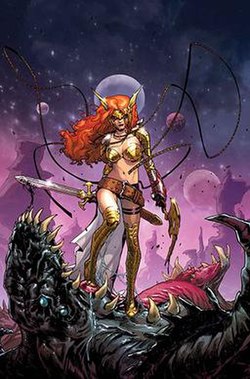Marvel Comics history
During the 2013 "Age of Ultron" storyline, Angela is revealed to be alive and has been pulled from Heaven as a result of Wolverine's damage to the Omniverse. [15] In a combination of rage and confusion, she charges towards Earth from outer space, only to be intercepted by the Guardians of the Galaxy, leading to her joining the team. [16]
During the Original Sin storyline, it is revealed that she is Aldrif, the daughter of Odin and Freyja, making her sister to Thor and Loki. She was "killed" as an infant during Asgard's war with the Angels of the Tenth Realm called "Heven." This crime resulted in Odin severing the Tenth Realm from the other nine as punishment for their attack. Thor learns of his sister's existence when he is exposed to the secrets of Uatu, the Watcher's eye, by the Orb. He returns to Asgard to confront his mother about Angela's existence, and subsequently travels to the Tenth Realm with Loki to learn more about his sister. [17]
The Guardians of the Galaxy and Angela are attacked in warp space by a band of pirates, called Warpjackers. During the battle, Angela abandons the Guardians when the adult Loki telepathically tells her that the portal to Heven is open and that she can return home. As Thor battles Heven's guards, Angela appears having been guided to the doorway to Heven by Loki, and prepares to battle Thor. [18] Angela fights an exhausted Thor who had just fought off the army of Heven, and is then told by the Queen of Angels to bring Thor to her. The now-female Loki has aligned with the Angels, telling Thor that "being on the winning side seems just perfect." [19]
While Loki leads an Angel fleet to Asgard, under the false pretence to help them destroy it, Thor escapes captivity and engages Angela in combat once again. [20] The fight between Thor and Angela is interrupted when Odin (who Loki freed from his self-exile) arrives and recognizes Angela as his daughter, revealing Angela's true lineage as the long thought dead Aldrif. A long time ago, the Angel tasked to dispose of Aldrif's body found out the baby was alive and raised her as one of the Angels under the name of Angela. In light of this revelation, the Queen of Angels grants Angela her life, pardoning her for her service to the Angels, but exiles her from Heven due to her lineage. After leaving Heven, Odin tells Thor, Loki, and Angela that he still loves his children. Angela then decides to leave in order to explore the other realms. [21]
Later, Angela and her lover Sera abduct the newborn daughter of Odin and Freyja. Unbeknownst to Odin, the baby is possessed by the spirit of Surtur and Odin orders Thor to hunt down the pair. Angela and Sera with help from the Guardians of the Galaxy, stay ahead of Thor and take the baby to Heven to be cleansed of Surtur's spirit. There, Angela throws the baby into the stalled engines of Heven. Surtur's fire is expelled from the baby and reignites the engines of Heven. For this action, Angela's debt to Heven is repaid and thus closes her last remaining connection to the realm. [22]
After Angela returns the baby to Odin, she discovers that Sera is actually Malekith the Accursed and the real Sera, who was previously killed in battle, remains in Hel. Angela travels to Hel and petitions Hela to restore her love to life. When Hela refuses, Angela launches a campaign of conquest with the help of Sera and Hela's handmaiden, Leah, completing several trials to become the new Queen of Hel. When she succeeds, she frees the souls of the dead Angels enslaved by Hel, and restores Sera to life, only to abdicate and return to Earth with Sera and Leah, having no need for power. [23]
Angela later joins Strikeforce, an Avengers-adjacent black ops team as the co-leader alongside Blade. [24]

